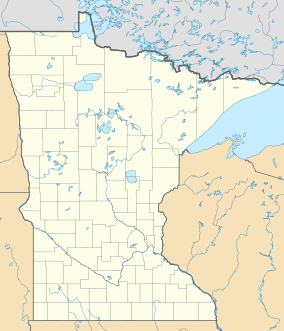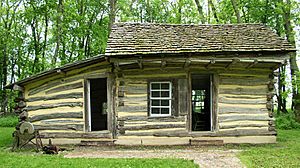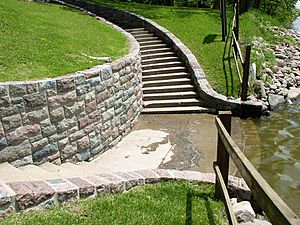Lake Shetek State Park facts for kids
Quick facts for kids Lake Shetek State Park |
|
|---|---|
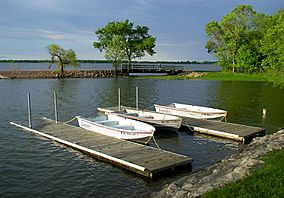
Rental rowboats and a WPA-built causeway to Loon Island
|
|
| Location | Murray, Minnesota, United States |
| Area | 1,109 acres (4.49 km2) |
| Elevation | 1,506 ft (459 m) |
| Established | 1937 |
| Named for | Lake Shetek |
| Governing body | Minnesota Department of Natural Resources |
|
Lake Shetek State Park WPA/Rustic Style Group Camp
|
|
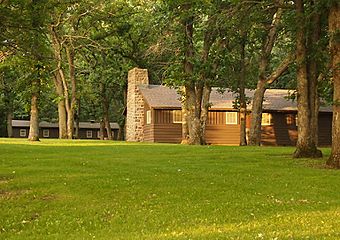
The Zuya Group Center
|
|
| Area | 2.5 acres (1.0 ha) |
|---|---|
| Built | 1940–1941 |
| Architect | Harold Peterson, N. Nielsen, Works Progress Administration |
| Architectural style | National Park Service rustic |
| MPS | Minnesota State Park CCC/WPA/Rustic Style MPS |
| NRHP reference No. | 92000777 |
| Added to NRHP | July 2, 1992 |
|
Lake Shetek State Park WPA/Rustic Style Historic District
|
|
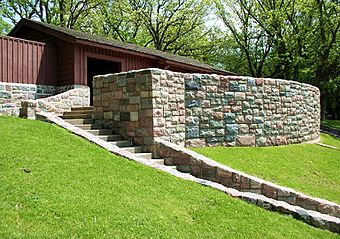
The Lake Shetek beachhouse
|
|
| Area | 34 acres (14 ha) |
|---|---|
| Built | 1938–1941 |
| Architectural style | National Park Service rustic |
| MPS | Minnesota State Park CCC/WPA/Rustic Style MPS |
| NRHP reference No. | 89001656 |
| Added to NRHP | July 2, 1992 |
Lake Shetek State Park is a fun place in Minnesota, United States. It is located on Lake Shetek, which is the biggest lake in southwestern Minnesota. This park is great for water activities and camping. It also has important history from the Dakota War of 1862. You can see an old log cabin and a monument there.
The park and lake were built up by the Works Progress Administration (WPA). This happened during the Great Depression. Many park buildings were made in a special "rustic" style. These buildings are now listed on the National Register of Historic Places.
Contents
Discover Lake Shetek State Park
Lake Shetek State Park covers about 1,109 acres. It is on the east side of Lake Shetek. The park is in Murray County, about 4 miles from Currie. It is also about 13 miles from Tracy and Slayton.
The park has almost 7 miles of shoreline along Lake Shetek. It includes Loon Island, which is 45 acres big. A 1,000-foot long causeway connects Loon Island to the mainland. The park also has two smaller lakes, two fish ponds, and two marshes.
The park sits on a high flat area called the Coteau des Prairies. This area is where Minnesota, South Dakota, and Iowa meet. There are not many natural lakes nearby. This makes Lake Shetek State Park a popular spot for visitors from other states.
Nature and Wildlife at the Park
How Lake Shetek Formed
Lake Shetek and the land around it were shaped by glaciers. This happened during the last Ice Age, about 15,000 years ago. The melting ice created channels in the land. Water from these channels formed Lake Shetek. The lake is quite shallow.
Plants and Trees in the Park
Long ago, most of the park area was prairie (grasslands). Early settlers said trees only grew on the islands. This was because wildfires could not reach them there. Later, settlers cut down many of these trees.
Now, the park has many trees like oak, hackberry, and elm. Park workers are trying to bring back the native prairie grasses. In the 1970s, a disease killed many elm trees on Loon Island. Their old trunks still provide homes for animals.
Animals and Birds in the Park
You can see many animals in the park. These include white-tailed deer, foxes, mink, and beavers. You might also spot fox squirrels, muskrats, and groundhogs.
The park is a great place for birdwatching. Many different birds visit the lake, woods, and marshes.
- Water Birds: Look for ducks, herons, coots, grebes, and white pelicans. Many of these birds nest here.
- Woodland Birds: You might see flycatchers, sparrows, thrushes, and many types of warblers.
- Marsh Birds: Keep an eye out for lesser yellowlegs and spotted sandpipers.
The name "Shetek" comes from an Ojibwe language word for pelican. Loon Island is named after a bird, but it's a bit of a mistake. The large diving birds seen by early settlers were double-crested cormorants, not common loons. People used to hunt cormorants here. Now, you only see them during migration.
History of Lake Shetek
Early People and Settlers
The first people around Lake Shetek were likely following bison. Later, people from the Great Oasis culture lived here. Archaeologists found two ancient burial mounds in 1973. By the time Europeans arrived, the Dakota people lived in this area.
Explorers like George Catlin and Joseph Nicollet visited in the 1830s and 1840s. The first European settlers arrived on the east shore of Lake Shetek in 1856.
The Dakota War of 1862
By 1862, about six families lived near Lake Shetek. This was a frontier area. The growing number of European settlers made it hard for the native Dakota people. They faced hunger because of broken treaties and unfair payments from the United States government.
On August 20, 1862, some Dakota groups came through the settlement. They attacked the settlers. Some settlers were able to escape. Others were taken captive. In the end, 15 settlers from six families died. 21 settlers survived the attack and found safety. Eight captives were later rescued and reunited with their families.
Two months later, the victims were buried near the lake. In 1925, a tall granite monument was put up to remember them. This monument is 25 feet high. Four years later, a 10-acre state park was created around the monument.
The original Koch family home, built in 1859, was later moved into the park in 1962. It is now a historic cabin. For the 100th anniversary of the event in 1962, 1,500 people came to the park.
Building the Park with the WPA
Lake Shetek State Park really grew in the 1930s. This was part of a big government plan called the New Deal. It helped people find jobs during the Great Depression. The Works Progress Administration (WPA) built many things in the park. They also planned to build causeways across the lake.
The state bought 181 acres of land for the park. This included Keeley and Loon Islands. In 1934, a WPA camp was set up on Keeley Island. About 200 men lived there. They built roads, campgrounds, picnic areas, and the beach. They used local wood and stone to build structures. These included a beachhouse, picnic shelter, and causeways. They also built a group camp called the Zuya Group Center.
The WPA stopped working when World War II began. One causeway between Keeley and Loon Islands was not finished. Keeley Island was later sold. The WPA camp there is now used by Shetek Lutheran Ministries.
Even though the monument site was a park in 1929, more land was added. In 1937, the Minnesota Legislature officially made Lake Shetek one of ten state parks.
In 1992, two areas of WPA buildings in the park were added to the National Register of Historic Places.
- One area is 34 acres along the lake. It includes the 1938 causeway to Loon Island and the 1939 beachhouse. It also has beachhouse steps, a kitchen shelter, a restroom building, and drinking fountains from 1940.
- The other area is 2.5 acres at the Zuya Group Center. It includes the 1940 mess hall and the 1941 crafts and recreation building.
The beachhouse and its curving double staircase are very special. One historian called it "one of the most attractive designs in the park system."
Recent Park Changes
Since it was built, Lake Shetek State Park has grown. Around 1950, fish-rearing ponds were added. These ponds helped stock local lakes with fish. The park now manages these ponds.
The park has expanded several times since the 1960s. A park office was built in 1965. It is now an interpretive center. A new office was built in 1992. In 1996, a paved trail connected the park to Currie.
Starting in 2010, a new campground was added for RVs. The old campground was also updated. The Oak Woods Campground now has fewer sites. This gives campers more privacy. It also helps protect Lake Shetek from runoff.
Fun Things to Do at Lake Shetek
Lake Shetek State Park is a great place for water fun. You can launch motorboats and canoes here. The park also rents out non-motorized boats. There are trails to reach two smaller lakes in the park. A swimming area is located near the beachhouse.
You can fish for many types of fish in Lake Shetek. These include walleye, northern pike, perch, and crappie. In winter, many people enjoy ice fishing for crappies.
The park has 70 campsites for cars. Most of them have electricity. The Oak Woods Campground also has four camper cabins. There are eight cart-in sites for tents. This campground has flush toilets and showers. There is also a group camp for up to 30 people.
You can explore 14 miles of hiking trails. A 1.5-mile interpretive trail goes across the causeway to Loon Island. A 6-mile paved trail connects the park to Currie. This trail is part of the Casey Jones State Trail. It is great for jogging, biking, and inline skating. In winter, 5 miles of trails are open for snowmobiles.
The park has a small visitor center with displays. The restored Koch Cabin shows how people lived long ago. You can visit it during business hours. The Eastlick Marsh has an observation deck. It has a spotting scope for birdwatching.


